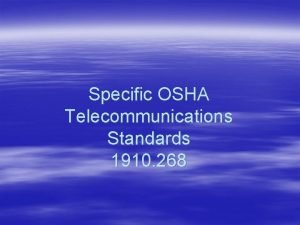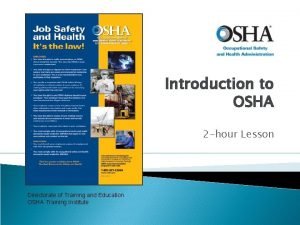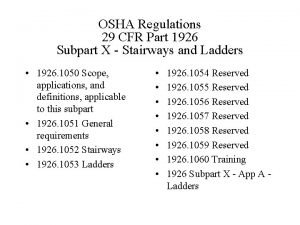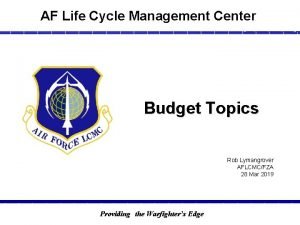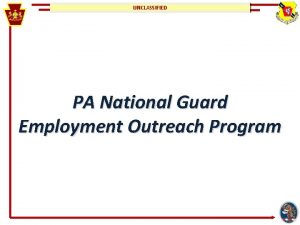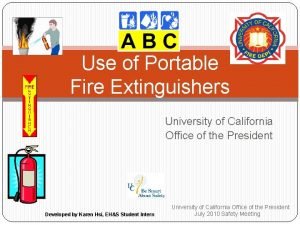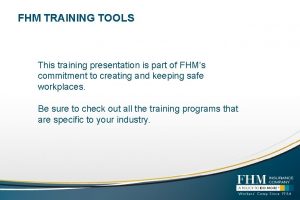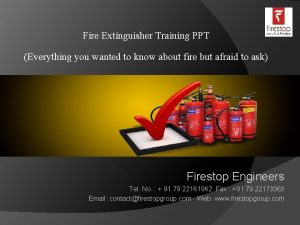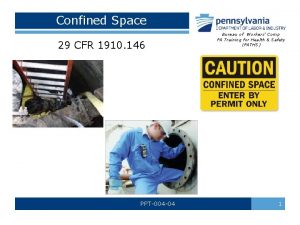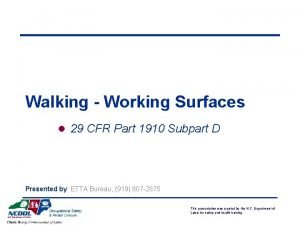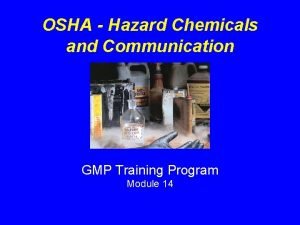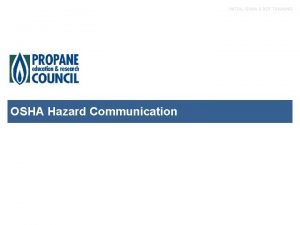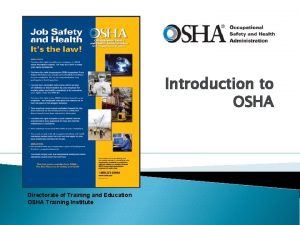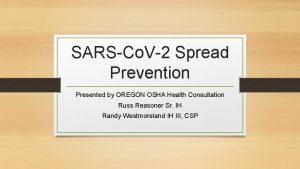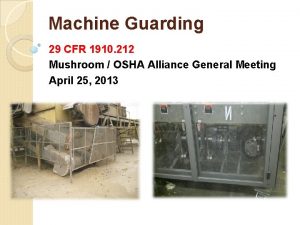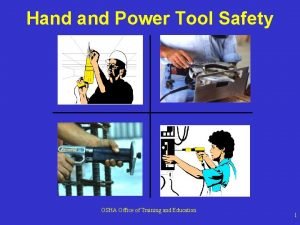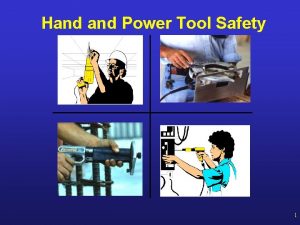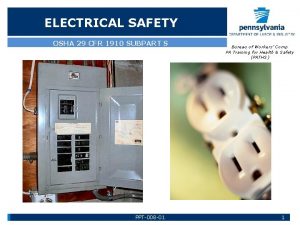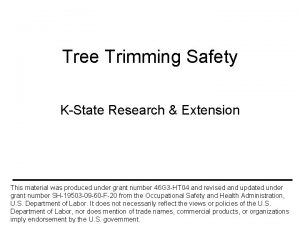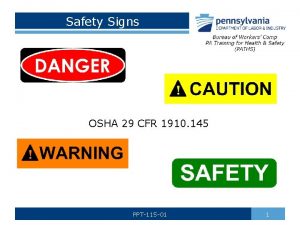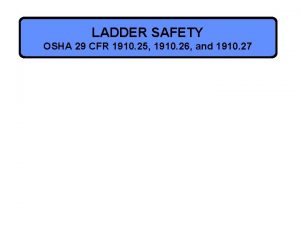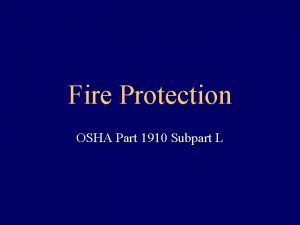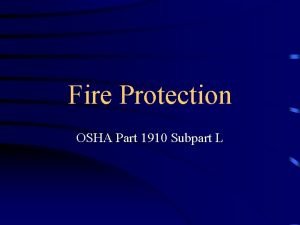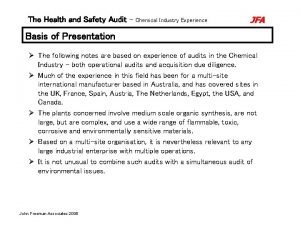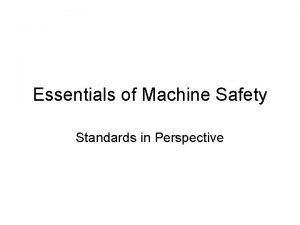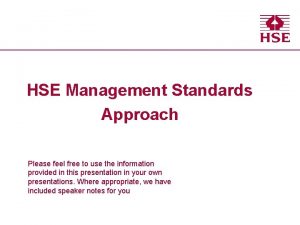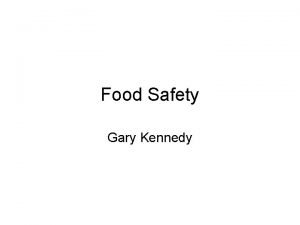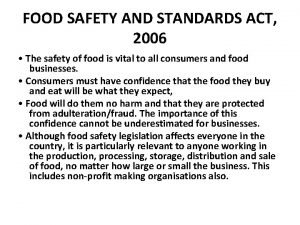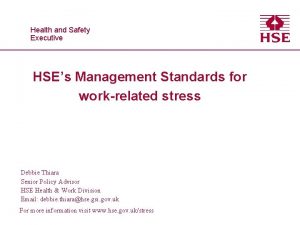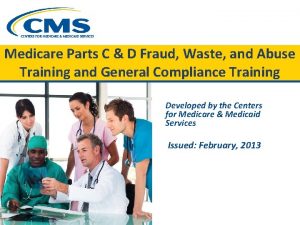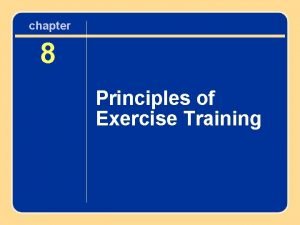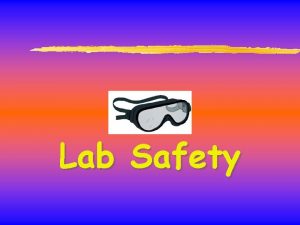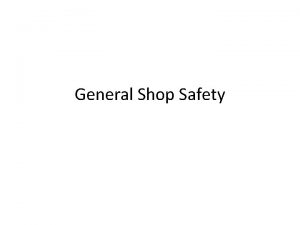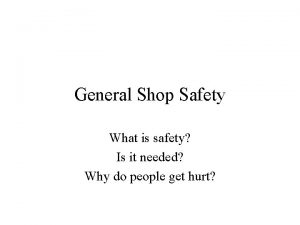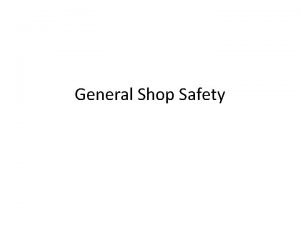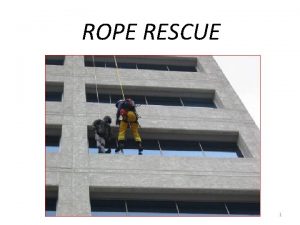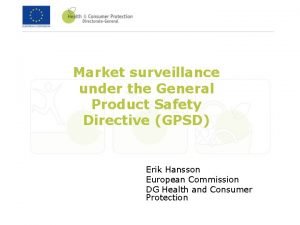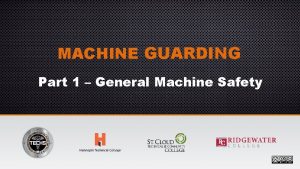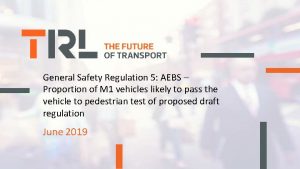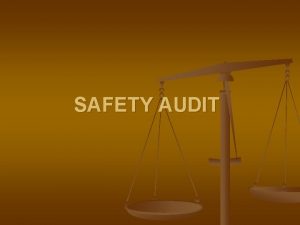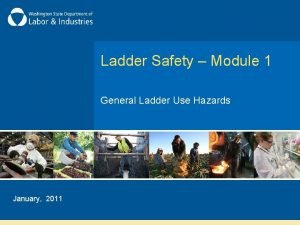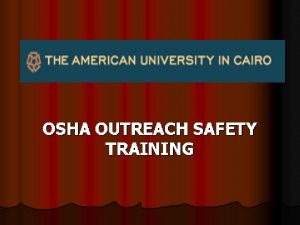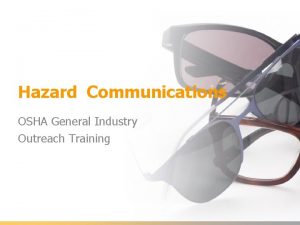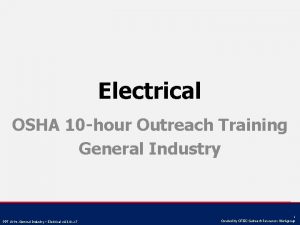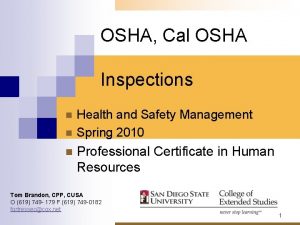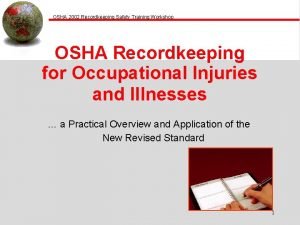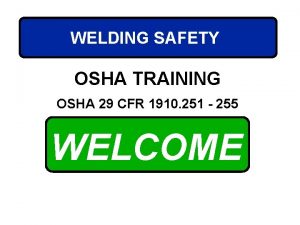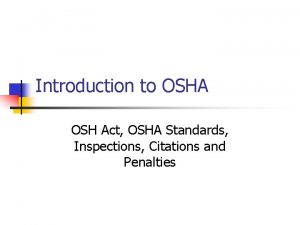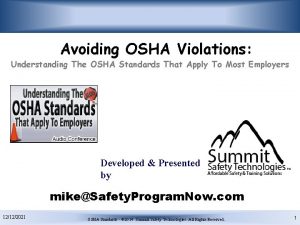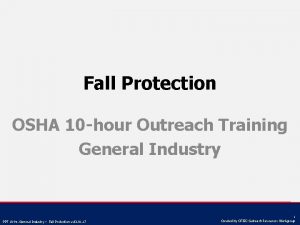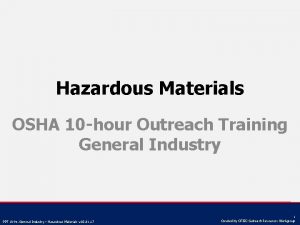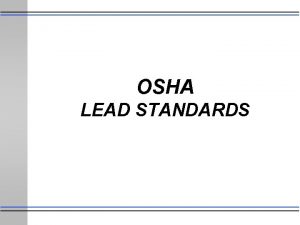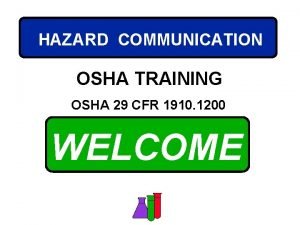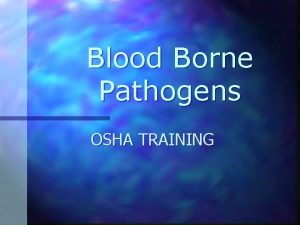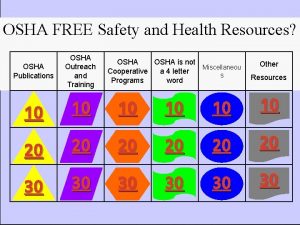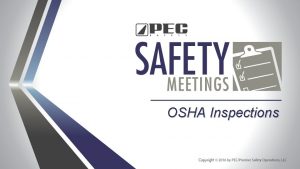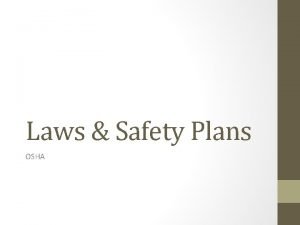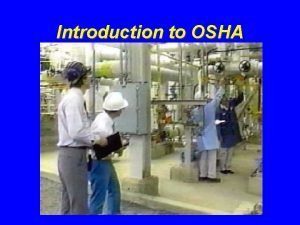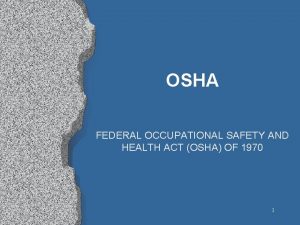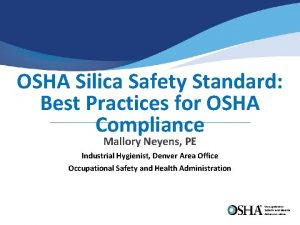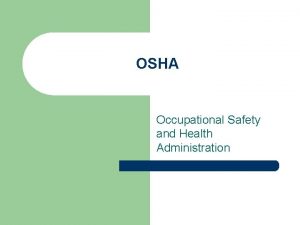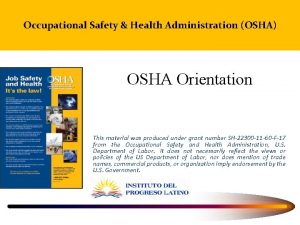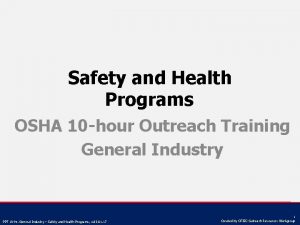OSHA Outreach Safety Training General Industry Safety Standards













































































- Slides: 77


OSHA Outreach Safety Training General Industry Safety Standards Welding, Cutting, and Brazing ﺃﻌﻤﺎﻝ ﺍﻟﻠﺤﺎﻡ ﻭﺍﻟﻘﻄﻊ Subpart Q & Subpart J 29 CFR 1910. 251 – 29 CFR 1910. 255 29 CFR 1926. 350 – 29 CFR 1926. 354


General Hazards • General Hazards of welding include: • Electrical Hazards ﻣﺨﺎﻃﺮ ﺍﻟﻜﻬﺮﺑﺎﺀ • Harmful Fumes ﺍﻷﺪﺧﻨﺔ ﺍﻟﻀﺎﺭﺓ • Heat and Light ﺍﻟﺤﺮﺍﺭﺓ ﻭﺍﻟﻀﻮﺀ ﺍﻟﻤﺒﻬﺮ Radiation • Fire and Explosions ﻭﺍﻹﻧﻔﺠﺎﺭﺍﺕ ﺍﻟﺤﺮﺍﺋﻖ



Acute health hazards • Skin irritation • Eye irritation • Inhalation 4 f

Acute health hazards • Ingestion • Observable effects 4 g

Chronic health hazards • Carcinogen • Kidney damage • Respiratory damage 4 h





Types of Welding ﺃﻨﻮﺍﻉ ﺍﻟﻠﺤﺎﻡ • Gas Welding (oxy-acetylene gas) ﺍﻟﻐﺎﺯ • Arc Welding (SMAW – Shield Metal Arc Welding) – (MIG – Metal Inert Gas) – (TIG – Tungsten Inert Gas) • Oxygen and Arc Cutting









Filter Lens Shade Number Guide Welding Operation Shade Number Shield Metal Arc Welding up to 4 mm electrode 10 Shield Metal Arc Welding (4. 8 to 6. 4 mm) electrodes 12 Shield Metal Arc Welding (6. 4 mm) electrode 14 Gas Metal Arc Welding (Nonferrous) 11 Gas Metal Arc Welding (ferrous) 12 Gas Tungsten Arc Welding 12 Carbon Arc Welding 10 – 14 Torch Soldering 2 Torch Brazing 3 or 4 Light cutting up to 25 mm 3 or 4 Medium cutting 25 to 150 mm 4 or 5 Heavy cutting over 150 mm 5 or 6 Gas welding (light) up to 3. 2 4 or 5 Gas welding (medium) 3. 2 to 12. 7 5 or 6 Gas welding (heavy) over 12. 7 6 or 8





29 CFR 1910. 253 Gas Welding and Cutting ﺍﻟﻠﺤﺎﻡ ﻭﺍﻟﻘﻄﻊ ﺑﺎﻟﻐﺎﺯ • An oxyacetylene welding outfits is basically made up of: cylinders of oxygen and acetylene, regulators, hoses, and a torch. • Oxygen and Acetylene are stored in separate cylinders in a high pressure, which is controlled by the regulators. • Hoses carry the gases from the cylinders to the torch. The green hose carries Oxygen. The red Hose carries Acetylene. • The gases are mixed inside the torch. When burned they produce a very hot flame. The flame is regulated by interchangeable torch tips and by the torch valves.


Flash Back Arrestor on the acetylene and oxygen regulators

Gas Welding Flashback Arresters • Flashback during oxy-fuel welding, cutting can cause serious injury. • All gas welding or gas cutting equipment must be fitted with flash arresters. • Flashback begins when the flame moves back from the welding tip and into the blowpipe, usually with a loud “bang” or a shrill hissing sound. • Without a flashback arrester, the flame can travel extremely fast about 13 meter a second – up gas supply hoses to the regulator and possibly into the gas cylinders where it could cause an explosion.

Non-return Valves on the Torch

Oxyacetylene Welding Equipment




General Requirements • Under no condition shall acetylene be generated or utilized at a pressure in excess of 15 psig. • Using acetylene at a pressure in excess of 15 psig is a hazardous practice. Free gaseous acetylene is potentially unstable at pressure above 15 psig and could decompose with explosive violence.

Continued • The decomposition characteristics of acetylene gas are avoided by keeping the gas in liquid solution and storing it in cylinders of unique construction. These cylinders contain porous calcium silicate filler (millions of microscopic pores) and a suitable solvent usually acetone. (has the ability to absorb over 400 times its own volume of acetylene at 70º F.


Continued • When absorbed in this filler, the acetylene is divided into such small units that, should acetylene decomposition take place in one pore, the heat released is not enough to raise the temperature of the acetylene in the surrounding pores. • Acetylene is usually supplied in cylinders which have the capacity of up to 300 cubic feet of dissolved gas under pressure of 250 psig at 70º F.

Continued • Cylinders shall be kept far enough away from the actual welding or cutting operation so that sparks hot slag, or flame will not reach them. When this is impractical shields shall be provided. • Cylinders containing Oxygen or Acetylene or any fuel gas shall not be taken into confined spaces. • Oxygen cylinders and fittings shall be kept away from oil or grease, and shall not be handled with oily hands or gloves.

Continued • Cracking: Before a regulator valve is connected, the valve shall be opened slightly and closed immediately. To clear the valve of dust or dirt. • The person cracking the valve shall stand to one side of the outlet, not in front of it. • Fuel gas cylinder valves shall be opened 1. 5 turns and the wrench shall be left in position on the stem of the valve.

Safety Precautions

Flashback Arrestor Workplace free from combustible materials Remove flammable materials Check with a leak spray or soap solution that there is no leakage Never expose the acetylene cylinder to strong heat A burning torch must not be hung on the regulator or expose the cylinder Adequate Ventilation

Cylinders and Containers • Compressed gas cylinders shall be legibly marked, for the purpose of identifying the gas content. (stenciling – stamping) • Cylinders should be stored away from elevators, stairs, or gangways, or other areas where they might be knocked over or damaged by passing or falling objects.



Continued • Where the cylinder is designed to accept a cap, shall always be in place, hand-tight, except when cylinders are in use or connected for use. The valve protection cap is designed to take the blow in case of cylinder falls. • Acetylene cylinders shall be stored valve end up.

Oxygen Cylinders • Oxygen cylinders in storage shall be separated from fuel-gas cylinders or combustible cylinders a minimum distance of 20 feet (6. 1 m).

Oxygen Cylinders • Or by a noncombustible barrier at least 5 feet (1. 5 m) high having a fire resistance rating of at least 1/2 hour.

ARC WELDING

29 CFR 1910. 254 Arc Welding and Cutting • Most of the electric welder are typically AC/DC, 240 volt transformer types using electricity as the energy source. • Arc welding uses the heat from an electric arc to melt and fuse base metals and welding-rod metal into one piece. The heat from the arc melts the flux coating on the rod.


ARC WELDING • In arc welding, the intense heat needed to melt the metal is produced by an electric arc. • The arc is formed between the actual work and an electrode wire.


Some Types of ARC Welding • SMAW (Shielded Metal Arc Welding) • GMAW (Gas Metal Arc Welding) • GTAW (Gas Tungsten Arc Welding)

SMAW (Shielded Metal Arc Welding) • Consists of an AC/DC arc burning between a consumable electrode and the workpiece to melt the joint area. • The arc and the weld pool are shielded by gases and slags which result from the decomposition of the electrode coating.

Arc Shielding • Metals at high temperatures tend to react chemically with elements in the air (oxygen – nitrogen) oxides and nitrides form which destroy the strength and toughness of the weld joint. • Protective covering with protective shield of gas, vapor, or slag.

GMAW (Gas Metal Arc Welding) (MIG) Metal Inert Gas • Means the use of an inert (i. e. non active) gas. • The process consists of a DC arc burning between a thin bare metal wire electrode and the workpiece. • The arc and weld area are enveloped in a proactive gas shield. • The wire electrode is fed from a spool, through a welding torch which is connected to the positive terminal into the weld zone.



GTAW (Gas Tungsten Arc Welding) TIG (Tungsten Arc Welding) • Consists of an AC/DC arc burning between a nonconsumable electrode and the workpiece to melt the joint area. • The area of the arc is enveloped in a protective gas shield which protects the weld pool and electrodes from contamination while allowing a stable arc to be maintained. • The filler wire is added by hand, or in the mechanised process, by feed rollers attached to the torch. • For high quality welding on stainless steels, aluminium.

Tungsten Inert Gas • DC most normally used for TIG welding of stainless steels, mild and low alloy steels, copper. • The electrode must be connected to the negative terminal, where one third of the heat is generated. Two thirds of the heat of the arc is generated at the positive pole. • A tungsten electrode connected to the positive pole would overheat and melt causing contamination of the weld and cracks in the ceramic shroud. • AC is used only for welding of aluminum, magnesium. Surface oxidation is removed automatically by the action of the arc each time the electrode becomes positive.

Safety Measure • The tungsten electrodes contain small amounts of thorium (less than 4%) which readily burning in air forming thorium oxide. • Thorium is a radioactive metal and poses an inhalation and ingestion hazard. • Good insulation of all power cables. • Secure welding return clamps and protection against arc radiation.




Installing the Arc Welder • The frame or case of welder shall be properly grounded. • A safety type disconnecting switch shall be located near the machine. • The welder shall be protected by properly sized fuse or circuit breaker on an independent circuit.

Continue • A ground return cable shall have a safe current carrying capacity equal to or exceeding the specified output capacity of the arc welding or cutting unit which it services. • Pipelines containing gases or flammable liquids or conduits containing electrical circuits, shall not be used as ground return.

Continue • All arc welding and cutting cables shall be of the completely insulated, flexible types, capable of handling the maximum current requirements of the work in progress. • Only cable free from repair or splices for a minimum distance of 10 feet from the cable end to which the electrode holder is connected shall be used.

Safety Measures • Since the inert-gas metal-arc welding process involves the production of ultra-violet radiation on intensities of 5 to 30 times that produced during metal-arc welding, the following safety measures to be followed: 1. The use of chlorinated solvents shall be kept at least 200 feet, unless shielded. Ultraviolet rays given off by welding can react with chlorinated hydrocarbon solvents, such as trichloroethylene, 1, 1, 1, trichloroethane, to form phosgene gas (deadly) 2. Employees in the area not protected from the arc by screening shall be protected by proper filter lenses. 3. Wet working conditions must be avoided because water is an excellent conductor and electricity will always follow the path of least resistance.

29 CFR 1910. 255 Resistance Welding • The weld is made by a combination of heat, pressure, and time. • It is the resistance of the metal to be welded to current flow that causes localized heating in the part. • The pressure is exerted by the tongs and tips. • The time is how long current flows in the joint



29 CFR 1910. 255 Resistance Welding • All doors and access panels of all resistance welding machines and control panels shall be kept locked and interlocked to prevent access, to live portions of the equipment. • All press welding operations, shall be effectively guarded by use of a device such as an electronic eye safety circuit, two hands controls, ….

Continued • The hazard of flying sparks shall be eliminated by installing a shield guard of safety glass or suitable fire-resistant plastic at the point of operation. • Two or more safety emergency stop buttons shall be provided on all special multispot welding machines. • Wear safety goggles or a face shield and heat resistance gloves.

 Georgia tech osha outreach portal
Georgia tech osha outreach portal Northern nevada adult mental health
Northern nevada adult mental health Osha telecommunications standards
Osha telecommunications standards Osha noise standard
Osha noise standard What are the osha construction standards also called
What are the osha construction standards also called Part 1926 subpart j of osha standards
Part 1926 subpart j of osha standards Ppn admin cbo
Ppn admin cbo Pengenalan program
Pengenalan program Drug outreach team belfast
Drug outreach team belfast Sam nelson outreach
Sam nelson outreach Nesac outreach facility
Nesac outreach facility Afman 65-605
Afman 65-605 Pch outreach program
Pch outreach program Hpd mental health division
Hpd mental health division National collaborative outreach programme
National collaborative outreach programme National guard employment network
National guard employment network Phytel appointment reminder
Phytel appointment reminder Gulf coast center mental health
Gulf coast center mental health Research outreach predatory
Research outreach predatory Cires education and outreach
Cires education and outreach Community health education outreach programs
Community health education outreach programs Ladder safety training ppt
Ladder safety training ppt Safety care training
Safety care training Cal osha fire extinguisher requirements
Cal osha fire extinguisher requirements Osha yard tractor training
Osha yard tractor training Youtube safety videos for workplace
Youtube safety videos for workplace Fire warden training ppt
Fire warden training ppt 1910 confined space
1910 confined space B13l
B13l Osha hazard and ghs training regulation cfr 1910
Osha hazard and ghs training regulation cfr 1910 Osha hazard communication inital training
Osha hazard communication inital training Osha directorate of training and education
Osha directorate of training and education Osha directorate of training and education
Osha directorate of training and education Osha directorate of training and education
Osha directorate of training and education Osha safety pyramid
Osha safety pyramid 1910 machine guarding
1910 machine guarding Osha hand and power tool safety
Osha hand and power tool safety Osha hand tools 1910
Osha hand tools 1910 Osha 1910 subpart s
Osha 1910 subpart s Osha tree trimming safety book
Osha tree trimming safety book Electrical safety signs and symbols ppt
Electrical safety signs and symbols ppt Osha robot safety
Osha robot safety Cfr 29 1910
Cfr 29 1910 Localization industry standards association
Localization industry standards association What is an edi segment
What is an edi segment Factors necessary for service standards are
Factors necessary for service standards are What is the general industry subpart for fire protection
What is the general industry subpart for fire protection 1910 subpart l
1910 subpart l Color 12212008
Color 12212008 Safety culture in aviation industry
Safety culture in aviation industry Safety audit in chemical industry
Safety audit in chemical industry Planos en cinematografia
Planos en cinematografia Where did general lee surrender to general grant?
Where did general lee surrender to general grant? Machine safety standards
Machine safety standards Food safety regulations and standards
Food safety regulations and standards Health and safety executive 6 management standards
Health and safety executive 6 management standards Food laws and regulations in pakistan pdf
Food laws and regulations in pakistan pdf Gary kennedy food
Gary kennedy food Food safety standards act 2006
Food safety standards act 2006 Health and safety executive management standards
Health and safety executive management standards Canada motor vehicle safety regulations
Canada motor vehicle safety regulations General ledger accounting training
General ledger accounting training Medicare parts c and d general compliance training answers
Medicare parts c and d general compliance training answers Principles of training program
Principles of training program General safety drawing
General safety drawing General shop safety
General shop safety 10 general shop safety rules
10 general shop safety rules General safety regulation
General safety regulation Getshopsafe
Getshopsafe General shop safety rules
General shop safety rules Nfpa 1983 summary
Nfpa 1983 summary General product safety directive
General product safety directive General machine safety
General machine safety General safety regulation
General safety regulation General safety audit definition
General safety audit definition General ladder
General ladder Training is expensive without training it is more expensive
Training is expensive without training it is more expensive Perbedaan on the job training dan off the job training
Perbedaan on the job training dan off the job training


